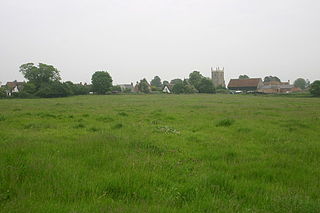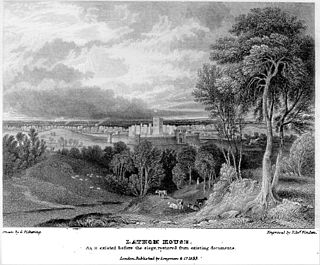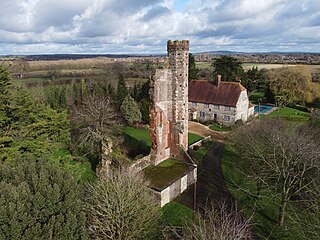
Peel towers are small fortified keeps or tower houses, built along the English and Scottish borders in the Scottish Marches and North of England, mainly between the mid-14th century and about 1600. They were free-standing with defence being a prime consideration in their design, although "confirmation of status and prestige" also played a role. Additionally, they functioned as watch-towers, where garrisoned personnel could light signal fires to warn of approaching danger.

Bodiam Castle is a 14th-century moated castle near Robertsbridge in East Sussex, England. It was built in 1385 by Sir Edward Dalyngrigge, a former knight of Edward III, with the permission of Richard II, ostensibly to defend the area against French invasion during the Hundred Years' War. Of quadrangular plan, Bodiam Castle has no keep, having its various chambers built around the outer defensive walls and inner courts. Its corners and entrance are marked by towers, and topped by crenellations. Its structure, details and situation in an artificial watery landscape indicate that display was an important aspect of the castle's design as well as defence. It was the home of the Dalyngrigge family and the centre of the manor of Bodiam.

Boarstall is a village and civil parish in the Aylesbury Vale district of Buckinghamshire, about 12 miles (19 km) west of Aylesbury. The parish is on the county boundary with Oxfordshire and the village is about 5.5 miles (9 km) southeast of the Oxfordshire market town of Bicester.

Marsh Gibbon is a village and civil parish in Buckinghamshire, England. It is close to the A41 and the border with Oxfordshire about 4 miles (6.4 km) east of Bicester.

Oakley is a village and civil parish in Buckinghamshire, England. It has an area of 2,206 acres (893 ha) and includes about 400 households. The 2011 Census recorded the population as 1,007.

Although the name Buckinghamshire is Anglo Saxon in origin meaning The district (scire) of Bucca's home the name has only been recorded since about the 12th century. The historic county itself has been in existence since it was a subdivision of the kingdom of Wessex in the 10th century. It was formed out of about 200 communities that could between them fund a castle in Buckingham, to defend against invading Danes.
High Ercall, also known in the past as Ercall Magna, is a village in the borough of Telford and Wrekin and ceremonial county of Shropshire, England. The civil parish is still called Ercall Magna, and had a total population of 1,679 at the 2001 census, reducing to 1,639 at the 2011 census. The parish includes the villages of Rowton, Ellerdine and Cold Hatton, and a number of hamlets including Cotwall, Osbaston, Poynton and Roden.

Modbury is a large village, ecclesiastical parish, civil parish and former manor situated in the South Hams district of the county of Devon in England. Today due to its large size it is generally referred to as a "town" although the parish council has not elected to give itself the status of a town as it could do under s.245(6) of the Local Government Act 1972, so it does not have a town council and cannot have a town mayor. It is also known informally as a "market town", as from at least 1199 the lord of the manor has held the right to hold a regular market. The village is situated on the A379 road, which links it to Plymouth and Kingsbridge. The current parish population is approximately 1,500.

Sir Henry Gage was a Royalist officer in the English Civil War.

Sir William Brockman (1595–1654) was an English landowner and military leader. He is best known for his staunch, if unsuccessful, defence of Maidstone in the Royalist cause, during the English Civil War.

Addingrove is a former hamlet in Buckinghamshire, about 4 miles (6.4 km) northwest of the market town of Thame in neighbouring Oxfordshire. The settlement is on the B4011 road between Oakley and Long Crendon.

The siege of Lathom House was a military confrontation between a Parliamentarian army and a Royalist stronghold in Lathom near Ormskirk in Lancashire, during the First English Civil War. The first siege lasted from late February to late May 1644, when the siege was lifted. The second siege took place a year later from July to December 1645. Lathom House was captured and slighted.

East Hendred is a village and civil parish about 4 miles (6.4 km) east of Wantage in the Vale of White Horse and a similar distance west of Didcot. The village is on East Hendred Brook, which flows from the Berkshire Downs to join the River Thames at Sutton Courtenay. Historically in Berkshire, it has been administered as part of Oxfordshire, England, since the 1974 boundary changes. The westernmost parts of the Harwell Science and Innovation Campus are in the parish. The Ridgeway and Icknield Way pass through the parish. It was called "the most well connected village in Britain" because of its connections with the railway station in Didcot and the M4 motorway. Champs Chapel Museum of East Hendred is a small museum in a former 15th-century wayside chapel.

Astley Castle is a ruinous moated fortified 16th century manor house in North Warwickshire, England. It has been listed as a Grade II* listed building since 1952 and as a Scheduled Ancient Monument since 1994. It was derelict and neglected since it was severely damaged by fire in 1978 whilst in use as a hotel and was officially a Building at Risk. The building reopened as a holiday let in 2012 after extensive and novel renovations that combine modern elements within the (mostly) renaissance remains. In 2013, Astley Castle won the Royal Institute of British Architects Stirling Prize for architecture, as an "exceptional example" of the blending of an ancient monument with modern architecture.

The siege of Basing House near Basingstoke in Hampshire, was a Parliamentarian victory late in the First English Civil War. Whereas the title of the event may suggest a single siege, there were in fact three major engagements. John Paulet, 5th Marquess of Winchester owned the House and as a committed Royalist garrisoned it in support of King Charles I, as it commanded the road from London to the west through Salisbury.

Pengersick Castle is a fortified manor house located between the villages of Germoe and Praa Sands in Cornwall, England. The tower house, which is in the parish of Breage, is a Grade I listed building. Parts of the building date from the early 16th century.

Warblington Castle or Warblington manor was a moated manor near Langstone in Havant parish, Hampshire. Most of the castle was destroyed during the English Civil War, leaving only a single gate tower, part of a wall, and a gateway. The property, now in the village of Warblington, is privately owned and does not allow for public access.

High Ercall Hall or Ercall Hall is the remaining part of a larger complex in the village of High Ercall, Shropshire, 8 miles (13 km) north-east of Shrewsbury.

Sir Richard Arches, of Eythrope, in the parish of Waddesdon, Buckinghamshire, was MP for Buckinghamshire in 1402. He was knighted before 1401.
Brill Palace was a medieval English royal residence located in the village of Brill in the Aylesbury Vale, Buckinghamshire. It was within the jurisdiction of the former Ashendon Hundred.



















